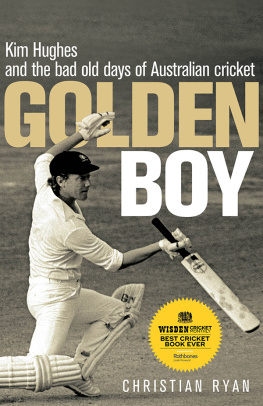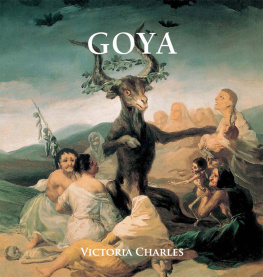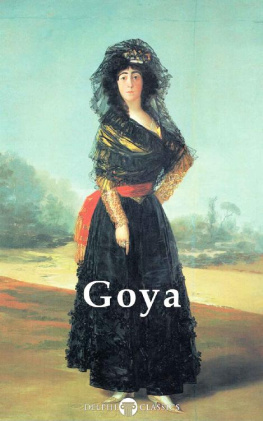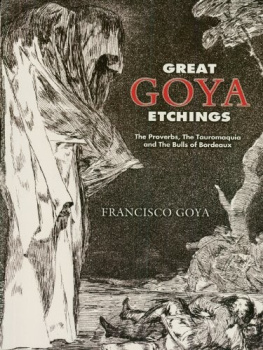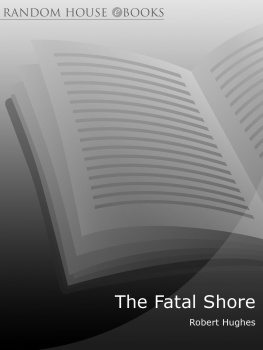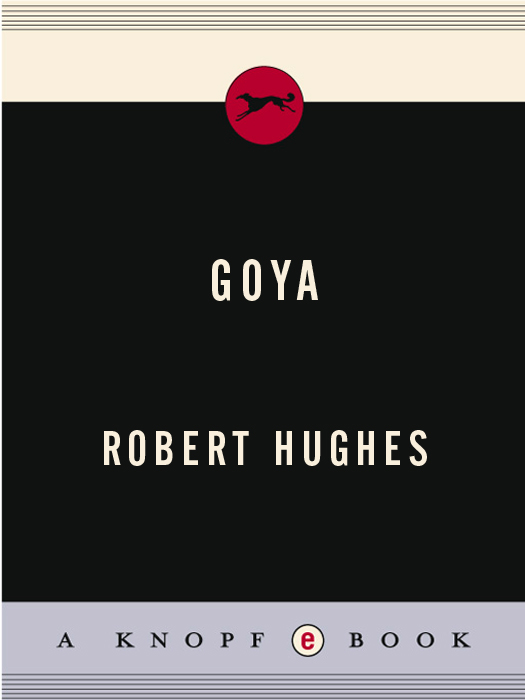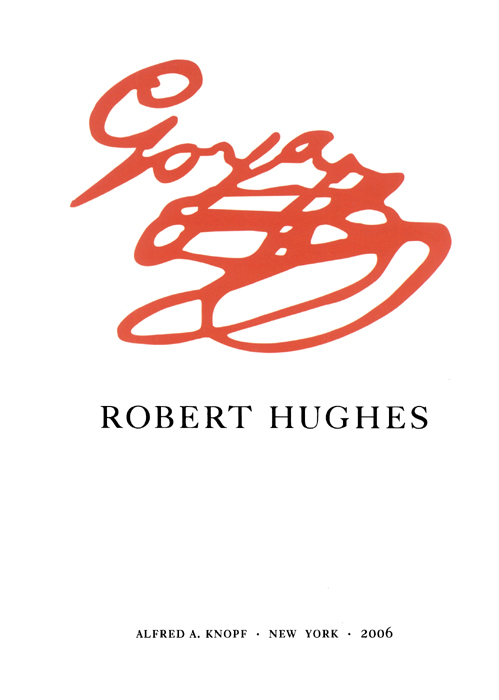

THIS IS A BORZOI BOOK
PUBLISHED BY ALFRED A. KNOPF
Copyright 2003 by Robert Hughes
All rights reserved. Published in the United States by Alfred A. Knopf, a division of Random House, Inc., New York, and in Canada by Random House of Canada Limited, Toronto.
www.aaknopf.com
Knopf, Borzoi Books, and the colophon are registered trademarks of Random House, Inc.
Library of Congress Cataloging-in-Publication Data
Hughes, Robert [date]
Goya / Robert Hughes.
p. cm.
Includes bibliographical references and index.
eISBN: 978-0-307-80962-9
1. Goya, Francisco, 17461828. 2. Goya, Francisco, 17461828Criticism and interpretation. 3. ArtistsSpainBiography. 1. Title.
N 7113. G 63 H 83 2003
760.092dc21
[ B ] 2002043281
:
Goya, Self-portrait in the Studio, 179495. Oil on canvas, 42 28 cm. Museo de la Real Academia de Bellas Artes de San Fernando, Madrid.
v3.1
For Doris
with all my love
CONTENTS
DRIVING INTO GOYA
I HAD BEEN THINKING about Goya and looking at his works for a long time, off and on, before the triggering event that cleared me to write this book. I knew some of his Antoine Watteau, without the pictorial merits of either and swollen with cellulite transplanted from Rubenswere part of every Australian lawyers or pub-keepers private imaginative life.
That was what my adolescent self fancied etchings were about: titillation. Popular culture and dim sexual jokes (Come up and see my etchings) said so. Whatever was on Goyas mind, though, it wasnt that. And as I got to know him a little better, through reproductions in booksnobody was exhibiting real Goyas in Australia all those decades ago; glimpsing El sueo de la razn was a flukeI realized to my astonishment what extremity of the tragic sense the man could put onto little sheets of paper. Por que fue sensible, the woman despairing in the darkness of her cell, guilty and always alone, awaiting the death with which the State would avenge the murder of her husband. Que se la llevaron! (They carried her off!): the young woman carried off by thugs, one possibly a priest, her little shoes sticking incongruously up as the abductors bend silently to their work. Tntalo (Tantalus): an oldish man, hands clasped, rocking to and fro beside the knife-edge of a pyramid in a despair too deep for words, and, across his knees, the corpse-rigid form of a beautiful and much younger woman whose passion cannot be aroused by his impotence. I could not imagine feeling like this manbeing fourteen, a virgin, and full of bottled-up testosterone, I didnt even realize that impotence could happen but Goya made me feel it. How could anyone do so? What hunger was it that I didnt know about but he did?
And then there was the Church, dominant anxiety of Goyas life and of mine. Nobody I knew about in Australia in the early 1950s would have presumed to criticize the One, Holy, Roman and Apostolic Church with the ferocity and zeal that Goya brought to the task at the end of the eighteenth century. In my boyhood all Catholicism was right-wing, conservative, and hysterically subservient to that most white-handedly authoritarian of recent popes, Pius XII, with his foolish cult of the Virgin of Fatima and the Assumption. In Goyas time the obsession with papal authority, and the concomitant power of the Church, was even greater, and to openly criticize either in Spain was not devoid of risk. I remember how my Jesuit teachers (very savvy men) used to say We dont try to justify the Inquisition anymore, we just ask you to see it in its historical contextas though the dreadful barbarity of one set of customs excused, or at least softened, the horrors of another; as though hanging and quartering people for secular reasons somehow made comprehensible the act of burning an old woman at the stake in Seville because her neighbors had testified to Inquisitors from the Holy Office that she had squatted down, cackling, and laid eggs with cabbalistic designs on them. It seemed to us schoolboys back in the fifties that, however bad and harshly enforced they were, the terrors of Torquemada and the Holy Office could hardly have compared with those of the Gulag and the Red brainwashers in Korea. But they looked awful all the same, and they inserted one more lever into the crack that would eventually rive my Catholic faith. So it may be said that Goyain his relentless (though, as we shall see, already somewhat outdated) attacks on the Inquisition, the greed and laziness of monks, and the exploitive nature of the monastic lifehad a spiritual effect on me, and was the only artist ever to do so in terms of formal religion. He helped turn me into an ex-Catholic, an essential step in my growth and education (and in such spiritual enlightenment as I may tentatively claim), and I have always been grateful for that. The thought that, among the scores of artists of some real importance in Europe in the late eighteenth century, there was at least one man who could paint with such realism and skepticism, enduring for his pains an expatriation that turned into final exile, was confirming.
Artists are rarely moral heroes and should not be expected to be, any more than plumbers or dog breeders are. Goya, being neither madman nor masochist, had no taste for martyrdom. But he sometimes was heroic, particularly in his conflicted relations with the last Bourbon monarch he served, the odious and arbitrarily cruel Fernando VII. His work asserted that men and women should be free from tyranny and superstition; that torture, rape, despoliation, and massacre, those perennial props of power in both the civil and the religious arena, were intolerable; and that those who condoned or employed them were not to be trusted, no matter how seductive the bugle calls and the swearing of allegiance might seem. At fifteen, to find this voiceso finely wrought and yet so raw, public and yet strangely privatespeaking to me with such insistence and urgency from a remote time and a country Id never been to, of whose language I spoke not a word, was no small thing. It had the feeling of a message transmitted with terrible urgency, mouth to ear: this is the truth, you must know this, I have been through it. Or, as Goya scratched at the bottom of his copperplates in Los desastres de la guerra: Yo lo vi, I saw it. It was unbelievably strange, but the yo made it believable.
A European might not have reacted to Goyas portrayal of war in quite this way; these scenes of atrocity and misery would have been more familiar, closer to lived experience. War was part of the common fate of so many English, French, German, Italian, and Balkan teenagers, not just a picture in a frame. The crushed house, the dismembered body, the woman howling in her unappeasable grief over the corpse of her baby, the banal whiskered form of the rapist in a uniform suddenly looming in the doorway, the priest (or rabbi) spitted like a pig on a pike. These were things that happened in Europe, never to us, and our press did not print photographs of them. We Australian boys whose childhood lay in the 1940s had no permanent atrocity exhibition, no film of real-life terror running in our heads. Like our American counterparts we had no experience of bombing, strafing, gas, enemy invasion, or occupation. In fact, we Australians were far more innocent of such things, because we had nothing in our history comparable to the fratricidal slaughters of the American Civil War, which by then lay outside the experience of living Americans but decidedly not outside their collective memory. Except for one Japanese air strike against the remote northern city of Darwin, a place where few Australians had ever been, our mainland was as virginal as that of North America. And so the mighty cycle of Goyas war etchings, scarcely known in the country of my childhood, came from a place so unfamiliar and obscure, so unrelated to life as it was lived in that peculiar womb of nonhistory below the equator, that it demanded special scrutiny. Not Beethovens



